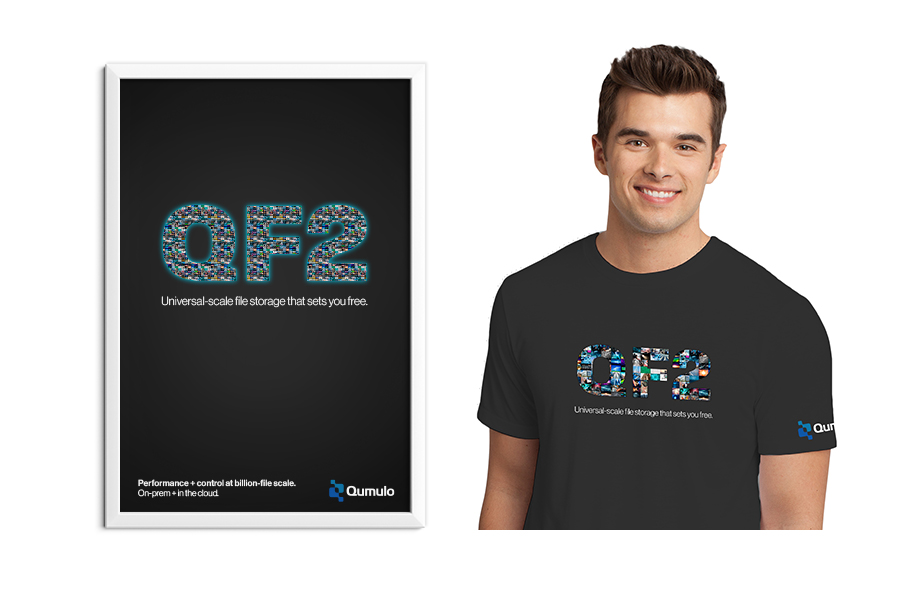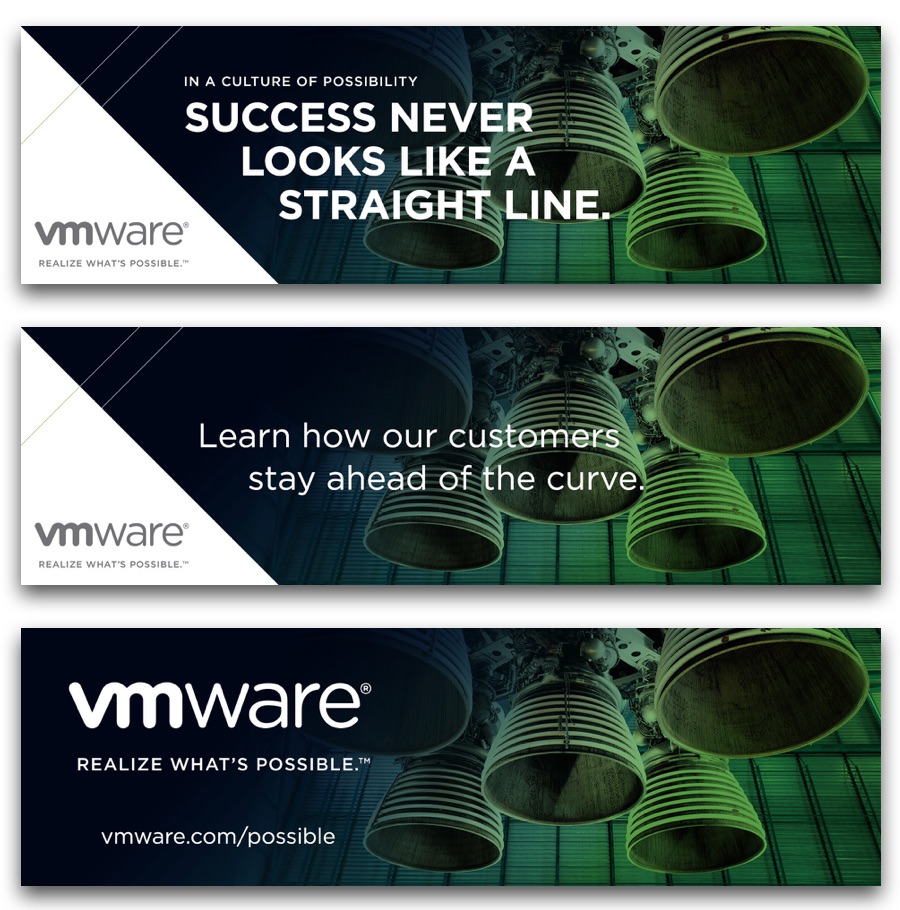Qumulo’s new Universal File Storage is ready for its close up…

And let’s not forget the banner…

|
Category: Technology
September 3rd, 2017
QF2: Qumulo Universal File Storage sets you freeQumulo’s new Universal File Storage is ready for its close up…
And let’s not forget the banner…
August 3rd, 2017
You bet the Network mattersOur new website for Savvius awaits your viewing pleasure…
March 4th, 2017
VMware: 2017 Brand CampaignKnown in every data center by IT practitioners, VMware is the leader in virtualization. However, as their offering expanded to cloud, mobility, security and beyond VMware needs to capture the attention of the C-suite. Mortar executed a full integrated campaign, including digital placements, OOH- primarily airport, high impact print placements such as cover wraps, campaign landing pages and social media.
   September 10th, 2016
What does it mean to market in the Cross-Cloud era? First whiteboard: the Cross-Cloud era lives. Palo Alto April 22, 2016. Strategic Marketing Decisions (SMDs) don’t come any bigger than last week’s announcement of VMware’s new cross-cloud architecture (which we helped create). With cross-cloud VMware is betting there is more money to made in catering to business’ need to consume different clouds than there is in building and marketing its own cloud.Here’s just some of what this, the single biggest decision about cloud since, well, the beginning of cloud (*celestial trumpets blare*), could mean for marketers like us: Cross-cloud is a massive new playground for innovation and delight.There are already a lot of clouds. Microsoft, Amazon and Google are the public clouds we know. But others also offer clouds: Joyent, Ninefold, Rackspace. Thousands more flavors are sure to follow. We must now shift from thinking of cloud as something offered by a small number of massive vendors to how we will surf across multiple environments custom-built for us by smaller, nimbler, more specialized providers. And VMware is the first of many trusted guides. Existing notions of hybrid cloud (public/private cloud) too will need to expand to allow for workloads that span the data center and multiple public clouds. With these new options, business gets the ability to draw on the power of infinitely dedicated resources when the need arises, without being limited by the capability and practices of one vendor. Which in turn means we can shift from marketing cloud as a good thing for service delivery and lower costs, to waking up to the possibilities that the cloud is an infinite canvas for innovation and progress. Cross-cloud is another reminder the future will be open.That cross-cloud is happening was not hard to predict. Technology is an irresistible disruptor and innovation abhors limit. AWS, for all its glory–and make no doubt about it, the rise of Amazon’s cloud is an epic success–is still a closed environment. AWS does not have an incentive to encourage other clouds. VMware’s cross-cloud move is one more indicator that the long-term future of technology will be open. And that whenever we are tempted to throw up walls around progress–all we do is tempt others to knock them down. Cross-cloud means we can drop the from “cloud”.For a decade now we have been figuring out how to talk about “cloud”. Now the singular is forever “clouds” plural we can drop the “the” and talk about the move to cloud without upsetting our grammar coaches. But we had better get a move on as ubiquity will soon give rise to irrelevance. After all, besides technologists talking to technologists do consumers really care how we get them services? They care more about what we get to them–and what they can do with their new powers. Cross-cloud means faster, cheaper, better marketing experiences.With diversity comes choice, competition, and the need for portability. Technically there is no such thing as a cross-cloud application just yet. Yet. The pundits say it is too tough. Mind you, several other Mortar clients have already made cross-cloud moves: With Habitat Chef have figured out how configuration can travel with apps across metal, on and off premises. Netskope offer protection against bad elements hidden in the cloud. And Cycle Computing has baked a model around making sense of out-of-control cloud pricing. His company, Cycle’s Rick Friedman says, enables organizations “to be cross-cloud by managing the mess behind the curtain“. And now one of the largest software companies in the world, VMware, have focused their entire strategy on the cross-cloud promise. As VMware CEO Pat Gelsinger said after VMworld: “VMware in the past has been about hardware freedom. VMware of the future will be about cloud freedom.” (Parent Dell followed suite by filing for multiple cross-cloud trademarks). For marketers, this is a reminder of our expanded ability to deliver richer digital experiences. Too much digital marketing remains focused on rudely interrupting people versus, say, giving them the opportunity to download an experience to their device. (For an example watch how Instagram now offers users the opportunity to download an app right from their feed). A wider range of specialized clouds opens the door to faster, more engaging, more personal delivery of digital brand extensions. In the cross-cloud era, choice and competition ride long with lower prices and improved delivery options. In the cross-cloud era imagination will increasingly take point.The big A-ha here is that cross-cloud is where the puck is going to be. The cloud is only ten years old, and already we are talking about more cloud, bigger apps, greater velocity, ever grander innovation and scale. It is no surprise technology is headed to the cloud. What is surprising is that the world is only just now waking up to the promise of engineering across multiple clouds. For a long time now advances in marketing have been wedded to developments in engineering (think cookies, CRM, Facebook, the conversation about agile). Where engineering goes, we tend to follow. Only maybe this time we can take point? The cross-cloud era has arrived folks. We’re thrilled to have played some role in the birth of the world’s foremost cross-cloud pioneer. Perhaps we can help you make sense of it too? September 3rd, 2015
Can we teach elephants to dance?Among the many cool ideas coming out of VMworld this week is the ongoing question of how long big business will continue to allow small, nimble and fast-moving start-ups like Uber and Airbnb steal their market. Much has been written on Uber’s rise to ascendancy in personal transportation—most of which has been gained at the expense of the taxi industry. But Uber owns no cars. Likewise Airbnb, an organization that owns no hotels, also threatens to disrupt the multi-billion dollar international hospitality industry. VMware’s CEO Pat Gelsinger, is asking an interesting question: now that the same technology (cloud and mobile technology) is available to all, surely big business—the proverbial elephants in the headline—will learn to cha-cha? Because if they don’t sashay their way to innovation, Gelsinger predicted, they will die: pointing to pundits who predict that 40% of the Fortune 500 will be replaced by 2025. Indeed, perhaps the most interesting question of all is why big business cannot innovate like a start-up, despite obvious advantages in the delivery department. We’ve spent the past year with our heads deep in VMware’s world (all the pun intended), and are more convinced than ever that change will continue to disrupt all we know to be true. To be honest, it’s working with this kind of change that gets us up in the morning. There’s a beer with your name on it if you can spot the touches we added. |
|